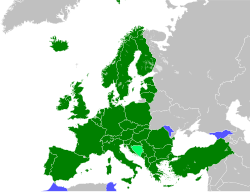European patent application
| Convention on the Grant of European Patents | |
|---|---|

European Patent Convention Contracting States in dark green, extension/validation agreement states in light green
|
|
| Signed | 5 October 1973 |
| Location | Munich, Germany |
| Effective | 7 October 1977 |
| Condition | six States on whose territory the total number of patent applications filed in 1970 amounted to at least 180 000 |
| Signatories | 16 |
| Parties | 38 |
| Depositary | Government of the Federal Republic of Germany |
| Languages | English, French and German |
|
|
|
The European Patent Convention (EPC), also known as the Convention on the Grant of European Patents of 5 October 1973, is a multilateral treaty instituting the European Patent Organisation and providing an autonomous legal system according to which European patents are granted. The term European patent is used to refer to patents granted under the European Patent Convention. However, a European patent is not a unitary right, but a group of essentially independent nationally-enforceable, nationally-revocable patents, subject to central revocation or narrowing as a group pursuant to two types of unified, post-grant procedures: a time-limited opposition procedure, which can be initiated by any person except the patent proprietor, and limitation and revocation procedures, which can be initiated by the patent proprietor only.
The EPC provides a legal framework for the granting of European patents, via a single, harmonised procedure before the European Patent Office. A single patent application, in one language, may be filed at the European Patent Office in Munich, at its branch in The Hague, at its sub-office in Berlin, or at a national patent office of a Contracting State, if the national law of the State so permits.
Before 1978, two important problems when seeking to obtain patent protection in Europe in a number of countries were first the need to file a separate patent application in each country, with a subsequent distinct grant procedure in each country, and secondly the need to translate the text of the application into a number of different languages. Different languages are indeed utilised across the European countries and there is substantial expense in preparing translations into each of those languages. While the European Patent Convention does not totally overcome the need for translations (since a translation may be required after grant to validate a patent in a given EPC Contracting State), it does centralise the prosecution in one language and defers the cost of translations until the time of grant.
In September 1949, French Senator Henri Longchambon proposed to the Council of Europe the creation of a European Patent Office. His proposal, known as the "Longchambon plan", marked the beginning of the work on a European patent law aimed at a "European patent". His plan was however not found to be practicable by the Council's Committee of Experts in patent matters. The meetings of the Committee nevertheless led to two Conventions, one on the formalities required for patent applications (1953) and one on the international classification of patent (1954). The Council's Committee then carried on its work on substantive patent law, resulting in the signature of the Strasbourg Patent Convention in 1963.
...
Wikipedia
